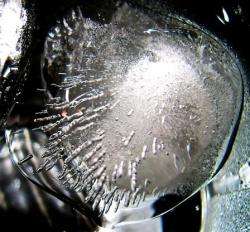June 24, 2009 weblog
Scientists Observe Liquid Water Below Freezing
Lisa Zyga
contributing writer

(PhysOrg.com) -- Below 0 °C, water turns to ice. But beyond that, or below about -75 °C, the ice may turn back into liquid water. While scientists have previously predicted this phase transition with computer simulations, recent experiments may have finally demonstrated the existence of this ultra-cold water.
In a their study, Dino Leporini of the University of Pisa in Italy and his colleagues at the Indian Institute of Science in Bangalore say they have seen two new phases of liquid water when the water is cooled to low temperatures and squeezed to high pressures. In low-density liquid (LDL) water, water molecules form an open network, while in high-density liquid (HDL) water, the molecules are close together and break some hydrogen bonds. These observations confirm the prediction of scientist Gene Stanley in 1992, who first suggested the two new phases.
Leporini and his coauthors had to overcome several technical challenges in their experimental setup, since water tends to freeze before it can be supercooled to extremely low temperatures. To get around these challenges, the researchers decided to confine tiny pockets of liquid water inside ice, and then cool the liquid water to temperatures down to -183 °C. Instead of measuring the water directly, the scientists used a probe molecule called TEMPOL, which is sensitive to the viscosity of the water. The probe moved with two kinds of liquid-like motion, as would be expected if there were two kinds of liquid water beneath the ice: a more fluid HDL form, and a more viscous LDL form.
According to an article in Nature News, experts are divided on whether or not the experiments truly demonstrate the new water phases. Pablo Debenedetti, a specialist on the physics of liquids at Princeton University, questions whether the two types of water in the experiments are actually two distinct phases, and suggests that the liquid forms could appear gradually rather than sharply. Water specialist Austen Angell at Arizona State University questions the purity of the water in the pockets, pointing out that seawater shuts out salt when it freezes, and the probe movements could simply be caused by assorted impurities.
Studying new phases of liquid water could have interesting implications for life. As Leporini explains, pockets of supercooled water in ice could host life in cold regions or on other planets where life has not previously been thought to exist.
via: Nature News
© 2009 PhysOrg.com
Written for you by our author Lisa Zyga—this article is the result of careful human work. We rely on readers like you to keep independent science journalism alive. If this reporting matters to you, please consider a donation (especially monthly). You'll get an ad-free account as a thank-you.
















